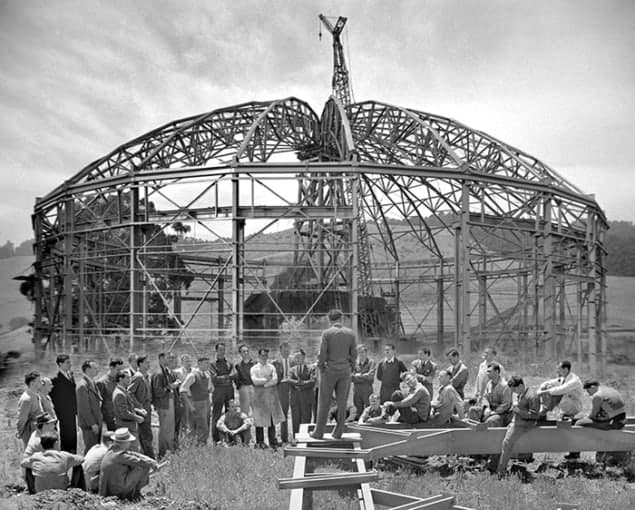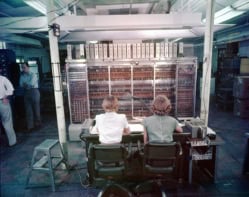David Wark reviews Big Science: Ernest Lawrence and the Invention that Launched the Military-Industrial Complex by Michael Hiltzik

As someone whose career has been spent building gargantuan underground neutrino detectors, I have often wondered what people centuries hence will make of “big science”. Will it have become so ingrained in the way science is done that people will not think of it as something that had to be invented? Or will the penchant for attacking big questions with big experiments have burned itself out, as the building of huge cathedrals seems to have done in Europe?
Whenever the era of big science ends, we can certainly say when it began. In the period just before, during and (especially) after the Second World War, laboratories devoted to projects too big to be accomplished in an individual university lab sprang up around the world. Michael Hiltzik’s Big Science recounts the beginnings of one such lab, the Radiation (or Rad) Lab at the University of California, Berkeley, in the context of a biography of its founding director, Ernest Lawrence. A towering figure of 20th century science, Lawrence is well worth a biography, and Hiltzik’s book makes an excellent read for those interested in the origins of our modern way of doing big science (and the influence of science on public policy), as well as the early days of nuclear physics.
The young Lawrence did not seem destined for greatness. Born in small-town South Dakota and initially sent to a small Lutheran college (from which a transfer for his second year at the University of South Dakota was a big step up), he fell under the influence of a charismatic teacher, William Swann, during graduate study at the University of Wisconsin (just as Lawrence would inspire his later acolytes, including no fewer than seven future Nobel laureates). Lawrence followed Swann through several institutions, all the while building his reputation as a master experimentalist and a person of extraordinary drive and persuasiveness. He settled at Berkeley in 1928 and remained there for the rest of his life, leading its transformation from a physics backwater to one of the world’s premier institutions in the field.
In 1929 Lawrence hit on the idea that would make his career and transform physics. In those early days of nuclear physics, discoveries were coming hot and fast (mostly in Europe), but there were limits to what could be achieved using particles supplied by natural radioactive sources. What was really needed was a way to artificially accelerate particles in a controlled beam to much higher energies than nature provides. Lawrence solved this problem by inventing the cyclotron, and the book does an excellent job of explaining the principles and importance of the device in simple terms.
All Lawrence’s machines were built in collaboration with others, and as he built bigger and bigger devices to achieve higher and higher energies (often starting on the next before the current one was operational), the teams got larger and larger. In building those teams, Hiltzik argues, Lawrence transformed not just one scientific problem, but the way some entire sciences are done. In time, the make-up of these teams morphed from jack-of-all-trades graduate students into groups of expert specialists, melding the skills of engineers, experimentalists and theorists to deliver projects beyond the scope of any small group.
Lawrence followed this model to assemble the teams that built the “calutrons” (a variant on the cyclotron) used to separate the uranium-235 used in the atomic bomb dropped on Hiroshima. This part of the story is particularly interesting, as it shines the spotlight away from Los Alamos and onto the equally important (and vastly larger and more expensive) efforts around the US to provide the exotic materials required for the bombs (the plutonium used in the “Trinity” test device and the Nagasaki bomb was first isolated in Lawrence’s lab as well).
The success of the Manhattan project to build the atomic bombs transformed governments’ views of science, moving scientists to the heart of critical policy discussions and vastly inflating budgets for big science projects. Lawrence rode this wave to gain even greater influence, and to expand his Rad Lab while also building a new laboratory in Livermore. However, there was a cost: as physics became important to politics, politics invaded physics, ending the public career of J Robert Oppenheimer and producing a decades-long rift within the community. (When I was a graduate student at the California Institute of Technology in the early 1980s, I suggested inviting Edward Teller to speak at a colloquium. The biting response from a senior professor was “We aren’t going to pay Teller to come here.”) Lawrence’s standing was badly damaged in the affair, which perhaps explains why, despite his enormous influence, physicists don’t speak of him with the awe they assign to Fermi or Bethe.
The book’s subtitle, Ernest Lawrence and the Invention that Launched the Military-Industrial Complex is unfortunate, because Lawrence certainly didn’t invent the military-industrial complex (just consider what was happening in Germany at the time), and the book doesn’t really claim he did. It does claim he invented big science, and here the case is stronger. The need to build huge apparatus to address deeper questions was inherent in the science, and similar developments were taking place in other sciences (for instance astronomy). Still, the Rad Lab undoubtedly pioneered the model of the major lab used today and had a huge influence on governments and funders. For this reason, I disagree with Hiltzik’s gloomy view of the future of big science, which I think he ties too much to collider physics, whereas in fact the model has moved into many fields.
The book will be a fun read for just about anyone interested enough to pick it up. The differences between Lawrence’s time and our own make fascinating reading, particularly in the shocking attitude to safety. Lawrence had a routine he called “the vaudeville” where he would drink a solution of radioactive sodium-24 and then hold his arm up to a Geiger counter to show how quickly it spread through the body. I wonder if the “ulcerative colitis” that eventually killed him was, in fact, radiation-induced colitis (a known delayed side-effect of radiation therapy with very similar symptoms) induced by this disregard of radiation safety? Another huge change is that all of the physicists in Lawrence’s group were men, and mostly white Christian men at that. After Berkeley hired Oppenheimer, they didn’t hire his protégé Bob Serber because a senior administrator said “One Jew in the department is enough.”
There are also lessons for all scientists in the fact that those at Rad Lab became so focused on building bigger and better machines that they missed a number of discoveries that could have been done with the machines they already had. For example, they failed to discover artificial radioactivity because nobody thought to look for activity remaining after the beam was shut off. In fact, they had wired the detector to turn off when the beam turned off – turning off a Nobel prize in the process.
The book contains a few minor errors in the physics (there are no cyclotrons in CERN’s Large Hadron Collider, isotopes of the same atomic number do not have identical chemistry, and so forth), but very few for a book on complex physics written by a non-scientist, and they don’t detract from the story. The details of Lawrence’s endless pursuit of foundations and rich donors for money may wear a bit for the non-specialist, but his boundless productivity and enthusiasm sweeps the reader along. To give just one example, in later life, while performing a crushing and eventually fatal load of administrative and advisory roles, Lawrence found time to tinker with the embryonic technology of colour television. His improvements were eventually included in the televisions sold by the Japanese company Sony, under the presumably unintentionally ironic name (given Lawrence’s involvement in the Manhattan project) of “Trinitron”. Lawrence was a central player in many of the great events of the 20th century, and this book is a valuable addition to our understanding of the period.
- 2015 Simon & Schuster £20.23/$30.00hb 528pp



